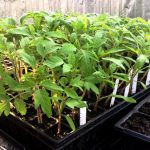Weekly Column – July 8th 2017
Keep on the Sunny-side!
I met a guy who told me a story about the power of food growing to create an understanding in children about nutritious food and sustainable living (or food ‘empathy’ as we’re fond of calling it in GIY). His children sowed sunflower seeds in planting cups in school, and then brought them home where they were planted down the end of the garden, against a south-facing wall.
In this high-tech age, he’s been astonished by the interest the children have shown in their sunflowers – there are daily trips to the end of the garden to measure progress, which with sunflowers is a satisfying thing indeed since they grow so rapidly (and up to 10ft tall eventually).
Then a miraculous thing happens – the plants produce enormous, beautiful sunflowers. The sunflower is one of the most animated, optimistic and downright cheery flowers you can have in your garden – the flower literally follows the sun across the horizon by day, only to turn back and face east by sunrise.
A joy to behold, but also the starting point in the sunflower’s demise –the flower eventually bows down and looks rather sad as it starts to die. But there’s time for one more miracle in which the dying plant suddenly becomes useful from a food perspective – the seeds in the flower head can be harvested for food. So from this strange plant, you get an unlikely abundance of seeds that can be nibbled on (wonderfully nutty) or sprinkled in to yoghurt or on top of porridge.
If this direct connection between the act of sowing a seed and the act of food-consumption wasn’t eye-opening enough for his kids, consider what happened next. It occurred to them that the seeds they were about to eat looked the very same as the seeds sown in soil months back. And so, a lightbulb moment occurred, where the full food lifecycle from seed to plant, plant to flower, flower to food, food to seed – was laid out before them. Food empathy is a deeper understanding of seasonality and the lifecycle of ‘growth-decay-growth’ which is so central to life on this planet.
The Basics – Onions
Generally speaking onions are ready when the tops of the plants fall over. An old trick was to bend the stems yourself, but this is now frowned upon. Many GIYers then loosen the soil around the bulb with a fork to accelerate bulb ripening and allow them some more space to swell – a suggestion I once received was to turn the onion very gently and very slightly in the soil, which presumably achieves the same thing.
A week or so after the stems have bent over, the leaves will wither and yellow. Lift the onions and shake off the soil. If the weather is dry, place them on a wire rack outside to dry. If rain is forecast, keep them on a rack in the greenhouse or tunnel. Leave for 10 days to dry out or until the skin is paper thin.
The presence of moisture in the onions is what causes them to rot in storage so make sure all the moisture is gone from them (particularly in the neck) before you store. Store in net bags or make a braid by twisting the onion tops around some wire. Store somewhere cool and dry. Remove any shoots that form over the winter.
Incidentally, summer onions can be used as required (fresh) straight out of the ground while you wait on the rest of the crop to ripen. In other words you don’t have to dry them out before using – the drying process is only to enable storage.




